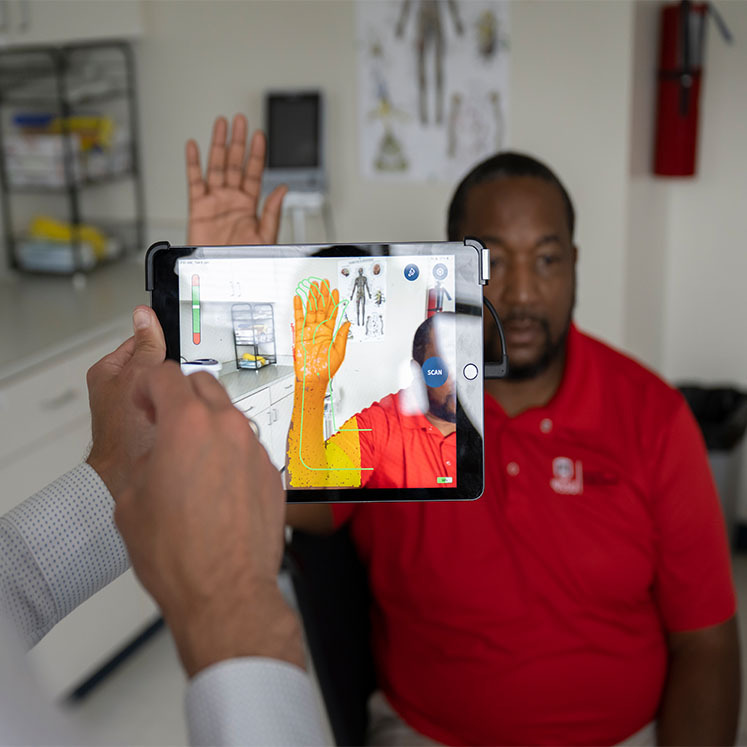Winston-Salem State University incorporates 3D printing of splints into occupational therapy curriculum
Winston-Salem State University has become the first university in the country to partner with Spentys to use 3D printing technology to produce high-quality, economic orthotic splints and introduce that technology into its occupational therapy curriculum.
Three WSSU instructors, Cynthia Bell, Ph.D., Chinno Ingram, Doctor of Occupational Therapy, and Sanchala Sen, Doctor of Occupational Therapy, worked together to research the platform offered by Spentys, a Belgium-based medical equipment manufacturer, and eventually received training in the process before making it available to students.
“This method captured our attention. It uses an iPad with a scanner, uses software to create a file, then upload and print,” said Ingram, a clinical associate professor in the WSSU department of occupational therapy. “It’s very economical. The therapist doesn’t have to spend the time to make a splint and instead can be working with the patient.”

According to its website, Spentys “offers a complete, efficient and clinically validated 3D scanning modelling and printing platform that enables healthcare providers to create high-quality, patient-specific orthoses faster and at lower cost.”
Bell, the department chair, discovered the technology during the American Occupational Therapy Inspire conference in 2022 and was immediately taken with it.
“I stopped and started chatting (with Spentys personnel) and was entranced by this transformational and innovational technology,” said Bell. “We stayed in touch and thought about how we could bring the technology to our program and integrate it into our curriculum.”
Bell wrote a proposal requesting funding to purchase the Spentys program and once that funding was available the trio went to work integrating it into the occupational therapy department.
WSSU and its occupational therapy department aren’t new to 3D printing; it’s something they have been doing since 2018. That familiarity with the process and the availability of 3D printers expedited the learning curve.
“We started off making assistive devices that could help people do everyday things, maybe a spoon or fork to help make them able to live more independently,” Ingram said of the department’s current 3D printing efforts. “Our students would identify a need, then design and create and provide to clients in the community.”
The process for creating a splint for a client via the Spentys process is very similar. The affected area of a client’s arm or foot is scanned with an iPad, a therapist determines the parameters of the splint needed and then either prints a standard model or free-hands one to be printed. Any straps and buckles needed can also be created in the platform. There is a WSSU photo gallery that shows the process.
The entire process, from scans to completed splint, is less than a day.
At present the Spentys platform has been approved only for use on arms and legs in the United States.
For decades the standard for making splints has been to fit clients using thermal plastic and then adding straps. The heated thermal plastic makes it an uncomfortable process for the patient and is work-intensive and expensive. That process, Sen says, “is not going away anytime soon” but the new platform offers an alternative effective, quick, and economic process.
“This is the cutting edge,’” said Sen. “We will still teach the regular way, but we want to expose our students to cutting-edge technology.”
In addition to being quicker and more inexpensive, 3D production of splints improves quality of life for clients. The 3D printed splints are made of hard plastic, are aerated, and can easily be taken off and put back on. They are also much more aesthetically pleasing, with several colors available.
“The client can engage in traditional day-to-day activities,” Ingram said of the 3D produced splints. “Now the client can shower with the splint on. They can take it off or leave it on in the shower. It’s not nearly as hot as normal splints.
“We can treat clients in a more acute manner. That’s where occupational therapists are experts. We’re getting them back to work doing something meaningful, back to work in the community.”
Not only will the new platform be introduced to WSSU’s occupational therapy curriculum, but also to the university’s community outreach programs.
“Our program is very community based. We send out students into the community for field work. We go to community clinics now,” said Sen. “We are hoping to serve the marginalized population with this.”
Earlier this month Spentys conducted a training session where faculty members engaged in the entire process, from scanning to printing.
“We are doing trials as a faculty, we are educating ourselves, we are going through the training,” said Bell. “We are working through integrating it into our curriculum.”
Current plans call for the process to be introduced to the occupational therapy curriculum in the spring of 2024.
